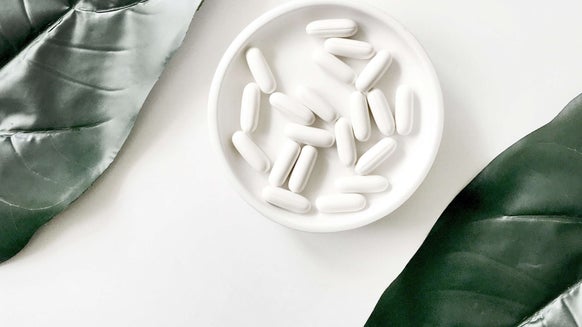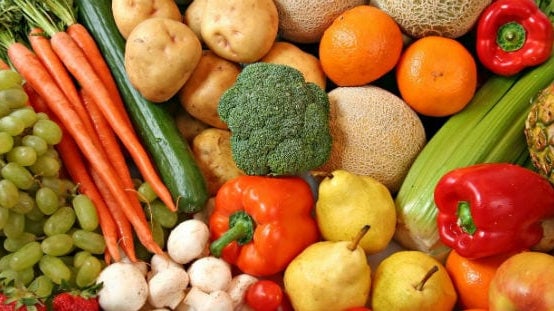How To Calculate A Calorie Deficit In 3 Steps

If you want to achieve sustainable weight loss, it’s crucial to understand the concept of calorie deficit.
So, let’s take a closer look at what calories are, what factors determine energy requirements, and how to calculate the all-important calorie deficit.
What are calories?
Specifically, one calorie is the amount of energy required to raise the temperature of 1 gram of water by 1 degree Celsius.
But to most people, calories are the way we measure the energy we get from food. It’s common to hear about calories in terms of the amount burned through exercise, but in fact all things we do, from breathing to thinking to digesting food, require energy and therefore “burn” calories.
What are the average calorie requirements for an adult?
According to the NHS, the recommended daily calorie intake is between 2,000-2,500.1 However, there are many things that can impact your daily energy requirements…
Factors that affect your calorie intake:
Physical activity: The more you move, the more energy you need. This is mostly affected by exercise, but the little things you do, like walking to work or having an active job, can have a considerable impact.
Illness: When recovering from illness, infection, or injury, the body requires more energy than usual. So it’s important to eat well when this is the case.
Medical conditions: Certain diseases and medical conditions can increase a person’s daily energy requirements.2
Body composition: Muscle requires more energy than body fat so those who have more lean muscle mass usually have higher calorie requirements.3,4
Gender: Men typically have higher calorie needs than women, usually due to having more muscle mass, lower body fat, and greater height.
Environmental factors: Temperature can impact BMR as the body has to work harder to maintain its normal temperature, e.g. sweating in hot weather.
Hormones: Fluctuations in hormones can influence energy expenditure. For example, various studies have found that during the luteal phase of the menstrual cycle, women can experience up to a 20% increase in their metabolic rate due to the increase in progesterone.5-7
What is a calorie deficit?
A calorie deficit is when you consistently consume fewer calories than your body expends.
For example, if your body requires around 2,000 calories per day but you consistently consume around 1,700 calories per day, you will be in a calorie deficit.

Food Calories Chart | What's In Your Fruit, Veg, Meat, And Other Daily Produce?
A guide on the calorie content of everyday foods.
How is a calorie deficit important for weight loss?
The one thing all weight loss diets have in common is calorie deficit. Whether it’s by consuming more protein or less carbs or fat, it’s the consistent reduction in overall calorie intake that leads to a reduction in body fat.
How much of a calorie deficit do I need for weight loss?
A daily deficit of around 400-1,000 calories per day is recommended for sustainable weight loss of between 0.5-1kg (1-2 lb) per week.
But remember that every person’s calorie requirements vary depending on lifestyle and environmental factors. Also be wary of setting unrealistic targets as this can lead to a lack of adherence.
How to calculate a calorie deficit | 3 steps
1. Calculate your daily maintenance calorie intake
The most accurate way of measuring a person’s energy requirements is through a technique known as direct calorimetry, which measures the rate of heat loss using a calorimeter.9 However, this method is rarely used due to its complexity and cost.
Instead, there are plenty of equations that can calculate approximately how much energy the body needs. The Harris-Benedict equation is probably the most popular, but the best is the Mifflin-St Joer equation below.10
This equation calculates approximate basal metabolic rate, or BMR, which is the number of calories that your body requires at complete rest. So, if you lay in bed all day, this is the amount of energy that your body would still require to carry out basic functions.
Calculating your TDEE
Your total daily expenditure (TDEE) is your maintenance calories and is worked out by calculating BMR plus any energy required for physical movement. This includes intentional exercise, but also the activity you do day-to-day, known as non-exercise activity thermogenesis (NEAT).
To calculate your TDEE, you simply multiply your BMR by a physical activity factor (PAL). PAL values should account for both your exercise and NEAT activity. The figure you get is your daily energy requirements to maintain your current body weight.
· Sedentary (little to no exercise): 1.2
· Lightly active (light exercise or sports 1-3 days a week): 1.375
· Moderately active (moderate exercise or sports 3-5 days a week): 1.55
· Very active (hard exercise or sports 6-7 days a week): 1.725
· Super active (very hard exercise and a physical job or training twice a day): 1.911
2. Adjust your calorie intake for weight loss
Once you know your body’s daily energy needs, you can calculate the number of calories needed for weight loss. It’s better to aim for a realistic calorie reduction with a goal of 0.5-1kg (1-2 lb) of weight loss per week.8

23 Meal Prep Recipes For Muscle Building & Fat Loss
You'll never have to wonder what to make for lunch again.
3. Consider your physical activity
Calorie deficits can come from a combination of both consuming less energy and using more energy.
If you have an already balanced diet and aren’t sure where to reduce calories, you might have to increase your movement to support a calorie deficit.
If you know you can reduce your portions and reduce your intake of high-calorie foods, you can focus on a greater calorie deficit from your food.
Calculating exactly how many calories you use during exercise is tricky, because it is not an exact science and will be influenced by various factors. The best way to estimate calorie burn is with a device that measures your heart rate and adjusts for your age, weight, and activity level.
How to Create a Calorie Deficit
1. Focus on realistic changes
If you’re already eating a healthy diet made up plenty of lean protein, fresh veggies, and whole grains, it might not be the best option to reduce your calorie intake too much
You could create a deficit by increasing your activity levels. This doesn’t need to be an extra gym session but could be getting off the train or bus a stop earlier to walk further, adding cardio to your regular gym session, or taking the dog for more daily walks.
On the flip side, if you are already pushing yourself 2 hours a day at the gym but don’t pay too much attention to your diet, it might be time to consider whether your diet might be holding you back.
2. Don't go too low
It can be tempting to go straight in for a higher calorie deficit with the aim of faster weight loss. However, extremely low calorie intakes or major deficits that result in quick weight loss are rarely sustainable.
Plus, if your calorie consumption is too low over time, your body will adjust and your BMR becomes lower, which makes it harder to lose weight.
Aiming for 0.5-1 kg of weight loss per week has been shown to be the most sustainable and the most likely to be maintained in the long term.8
3. Change it up... but not too much
If you’re sticking to your diet but your workouts aren’t getting you where you want to be, make sure you’re still pushing yourself. Continually tweaking your exercise routine is needed to keep progressing.
Just try to avoid making constant adjustments to your calories. What you do consistently will help you to achieve goals, so focus on consistency over time rather than daily perfection.

3 High-Protein Breakfast Recipes To Start Your Day Right
Breakfast can really make or break your day, so start strong.
What foods are good for a calorie deficit?
No single food or food group is best or worst when it comes to weight loss. Mostly, it comes down to energy balance. But this doesn’t mean you should just eat whatever you like as long as you’re below your maintenance calories.
Protein is particularly important when trying to lose weight, as it’s needed to maintain muscle mass. Additionally, try to eat as many vegetables, fruits, fibrous carbohydrates, and healthy fats as you can.
None of this means you should eat food you don’t enjoy eating. The “best” diet is one you can stick to long term. Feeling restricted or constantly hungry is likely to backfire and result in the diet being unsuccessful.
How to maintain a healthy lifestyle in a calorie deficit
Incorporate cardio and strength training
Cardio gives the most efficient calorie burn in a daily workout, but lifting weights is what can really change your body over time. Building mass by building muscle actually increases your BMR and burns more calories on a daily basis in the long term.
Strength training is doubly important during a calorie deficit because it will help you maintain your muscle mass while supporting fat loss.
Sleep more, stress less
Stress, both mental and physical, can dramatically affect your performance goals, which can cause even further stress.
The body responds to stress through a cascade of events. Cortisol is a steroid hormone normally released in response to “stressful” events, such as exercise, injury, and other high-pressure situations.
Cortisol carries many metabolic effects, and elevated cortisol is thought to stall weight loss and even promote weight gain, usually through fluid retention.
Focusing on sleep quality and quantity can also support a reduction of stress in the body, so ensure to get plenty of it.

The Two-Way Relationship Between Sleep & Exercise
See how sleep and exercise influence each other, and how to reap the benefits from both.
Changes to your diet in a calorie deficit
Increase your fiber intake
Fiber helps to keep us feeling full for longer, so fiber-rich foods like fruits, veg, pulses, legumes, and complex carbohydrates are valuable when in a calorie deficit.

What is Dietary Fiber? | 23 High-Fiber Foods
Good news: Popcorn made the list.
Keep your protein intake high
Protein is crucial for muscle repair and growth, but it’s especially important during periods of weight loss as it helps to maintain muscle mass. Plus, like fiber, protein is also highly satiating.

14 Foods Surprisingly High In Protein
The underdogs of the protein world have entered the chat...
Stay hydrated
Staying hydrated is important for optimal focus, performance, and health. Water is the best choice and contains no calories. Juices, fizzy drinks, and other sweet beverages can be high in calories. This doesn’t make them “bad”, but cutting them out can make a big contribution to a calorie deficit.
Consume less "added sugar" foods and drinks
When in a calorie deficit, you may become more aware of the calories and nutrients in certain foods. Some food products may contain high amounts of added sugar, which can add up over the course of a day and week.
Think about the sugar or syrups you may add to your morning tea or coffee, or fizzy drinks that you consume regularly, and consider if you can replace these with lower-sugar variations.
Of course, it’s what you do regularly that counts. Enjoying a sweet drink every now and then is not going to make or break your weight-loss plan.
Calorie deficit FAQs
Can you have takeout when you’re aiming for a calorie deficit?
No single food or food group needs to be cut out to create a calorie deficit, but energy-dense foods can make it harder. You can still enjoy takeout but aiming for leaner or lower-fat options might make it easier to remain in a deficit.
Can you build muscle when you’re aiming for a calorie deficit?
Technically, the goals of losing fat and building muscle contradict each other. In order to gain muscle mass, there needs to be a surplus of energy. This means that energy intake needs to be higher than the amount of energy than the body requires to maintain weight and all functions and activities. But to lose weight, an energy deficit is required.
There is the potential to lose a little fat and gain a little muscle simultaneously (obviously not at the exact same time, but over the same period). But the key word here is “little”. Building muscle is not easy to begin with, and without the right nutrition and training, muscle mass gain is likely to be minimal. The same applies to fat loss.
While a calorie surplus is beneficial and preferable for muscle growth, there are certain situations that make gaining muscle in a calorie deficit possible.
Certain dietary conditions may be better for building muscle and dropping body fat than others. One study found that when two groups of men consumed 40% fewer calories compared to their normal requirements, the higher-protein group gained muscle mass while the lower-protein group saw no change.12 The higher-protein group also lost significantly more body fat than the lower-protein group.
The results of this study indicate that plenty of protein while in a calorie deficit is the best route to losing fat and building muscle at the same time.
What should a vegetarian calorie deficit be?
Calorie deficit works the same no matter your dietary pattern, but protein intake is crucial for vegetarians. If you struggle to consume enough protein, opt for a more conservative calorie deficit to minimize muscle loss.
Why am I in a calorie deficit and not losing weight?
As much as weight loss and gain can be simplified to “calories in and calories out”, it’s not that simple in practice. Stress, sleep, and hormones can all impact things too.
For specialized diet advice tailored to your health and fitness goals, consider consulting a registered dietician or nutritionist.
Take home message
While calculating a calorie deficit is based on relatively simple science, the truth is we’re not robots and in reality it’s rarely as straightforward.
Take a close look at your lifestyle, habits, and schedule, and decide what sustainable changes you can make to cut your calorie intake over an extended period of time. If you’re prepared to accept that your goal may take some time to reach, you’ll be more likely to make the lasting changes needed to get there.
Enjoyed this article?
READ THESE NEXT:

- NHS. 2023. Understanding calories. Retrieved from: https://www.nhs.uk/live-well/healthy-weight/managing-your-weight/understanding-calories/
- Patel, D., Shan, A., Mathews, S., & Sathe, M. (2022). Understanding Cystic Fibrosis Comorbidities and Their Impact on Nutritional Management. Nutrients, 14(5), 1028. https://doi.org/10.3390/nu14051028
- Stehno-Bittel, Lisa. “Intricacies of fat.” Physical therapy 88, no. 11 (2008): 1265-1278.
- Liaqat, Ayesha, Kiran Fatima Nasir, Nimra Saeed, and Muneeba Javed. “True Facts About Burning Calories.” (2023). Biological Times.
- Howe, J. C., Rumpler, W. V., & Seale, J. L. (1993). Energy expenditure by indirect calorimetry in premenopausal women: variation within one menstrual cycle. The Journal of Nutritional Biochemistry, 4(5), 268-273.
- Benton, M. J., Hutchins, A. M., & Dawes, J. J. (2020). Effect of menstrual cycle on resting metabolism: A systematic review and meta-analysis. PLoS One, 15(7), e0236025
- Draper, C. F., Duisters, K., Weger, B., Chakrabarti, A., Harms, A. C., Brennan, L., … & Van Der Greef, J. (2018). Menstrual cycle rhythmicity: metabolic patterns in healthy women. Scientific reports, 8(1), 1-15.
- Raynor, H. A., & Champagne, C. M. (2016). Position of the Academy of Nutrition and Dietetics: Interventions for the Treatment of Overweight and Obesity in Adults. Journal of the Academy of Nutrition and Dietetics, 116(1), 129-147.
- Ndahimana, D., & Kim, E. K. (2017). Measurement Methods for Physical Activity and Energy Expenditure: a Review. Clinical nutrition research, 6(2), 68–80. https://doi.org/10.7762/cnr.2017.6.2.68
- Mifflin, M. D., St Jeor, S. T., Hill, L. A., Scott, B. J., Daugherty, S. A., & Koh, Y. O. (1990). A new predictive equation for resting energy expenditure in healthy individuals. The American journal of clinical nutrition, 51(2), 241-247.
- Westerterp, Klaas R. “Alterations in energy balance with exercise.” The American journal of clinical nutrition 68, no. 4 (1998): 970S-974S.
- Longland, T. M., Oikawa, S. Y., Mitchell, C. J., Devries, M. C., & Phillips, S. M. (2016). Higher compared with lower dietary protein during an energy deficit combined with intense exercise promotes greater lean mass gain and fat mass loss: a randomized trial. The American journal of clinical nutrition, 103(3), 738-746.








